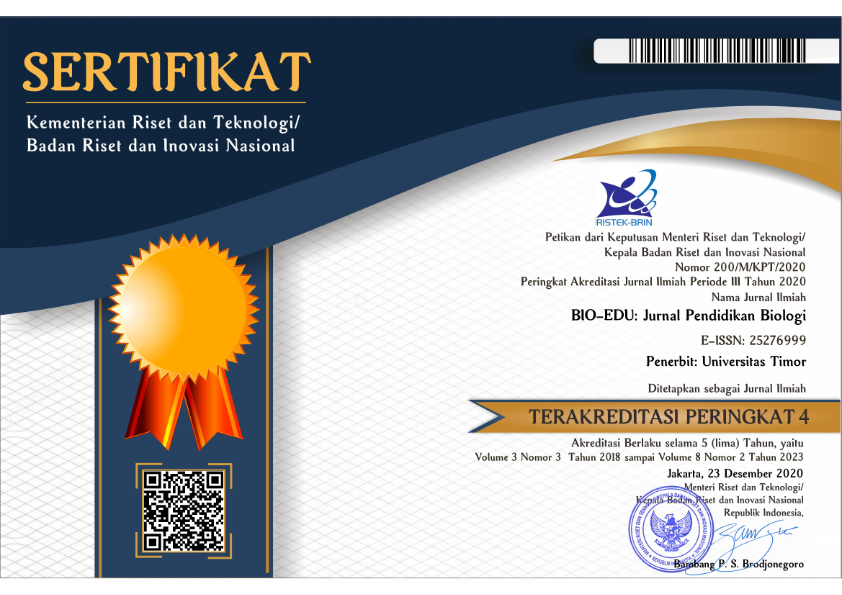TIPE INTERAKSI BAKTERI PENYUSUN KONSORSIUM DALAM DEGRADASI PARAQUAT
DOI:
https://doi.org/10.32938/jbe.v6i3.1995Keywords:
konsorsium bakteri, degradasi paraquat.Abstract
Penelitian ini bertujuan untuk mengetahui tipe interaksi bakteri penyusun konsorsium. Penelitian ini merupakan penelitian experimental dengan rancangan acak lengkap dengan 3 kali pengulangan Data yang diperoleh dari penelitian ini berupa: 1) kadar residu paraquat dianalisis menggunakan spektrofotometer UV-Vis; 2) jumlah populasi bakteri (CFU/mL) dan waktu inkubasi; 3) perhitungan jumlah koloni bakteri atau Total Plate Count (TPC); dan 4) pengukuran nilai Optical Dencity (OD) isolat bakteri. Data dianalisis secara statistik, sedangkan data penurunan persentase degradasi herbisida paraquat diuji menggunakan Two-Way Analysis of Varians (ANOVA) (derajat signifikasi = 5%), dilanjutkan dengan uji duncan. Hasil uji interaksi bakteri penyusun konsorsium menunjukkan bahwa adanya hubungan sinergis antar bakteri penyusun konsorsium dalam mendegradasi paraquat Hasil uji dengan Kit dan identifikasi bakteri didapatkan hasil bahwa pq1 adalah spesies Pseudomonas stutzeri, pq4 adalah spesies Acinetobacter sp., dan pq6 adalah spesies Micrococcus sp. Selain itu, hasil penelitian
juga menunjukkan bahwa formulasi bakteri berpengaruh terhadap degradasi paraquat di tanah
ditunjukkan oleh formulasi bakteri pq4pq6 sebesar 76.4%, diikuti pq1pq4pq6 sebesar 68.1%, pq1pq6 56.3%, pq1pq4 53.3%. Persentase degradasi tertinggi ditunjukkan oleh pq4pq6 sebesar 76.4%.
Kata Kunci: konsorsium bakteri, degradasi paraquat.
References
Anderson J. R., and Ekizabeth A. D., 1971, Growth Characteristics of a Spesies of Lipomyces and Its Degrdation of Paraquat, Journal of general Microbiology, 70 : 43-58.
Audus, L.J., 1969. The Physiology And Biochermistry of Herbicides. Academic Press, New York.
Baboo, M., Mamata P., Alka S., Monty K., Jitesh K M. and Amiya K P., 2013. Effect of Four Herbicides on Soil Organic Carbon, Microbial Biomass-C, Enzymes Activity and Microbial Population in Agricultural Soil, International Journal of Research in Environmental Science and Technology ISSN 2249–9695, 3(4): 100-112.
Carr, R.J.G., Bilton, R.F. & Atkinson, T., 1985. Mechanism of Biodegradation of Paraquat by Lypomyces starkeyi. Applied Environmetal Microbiology. 49:1290-1294.
Downloads
Published
Issue
Section
License
The Authors submitting a manuscript do so on the understanding that if accepted for publication, the copyright of the article shall be assigned to BIO-EDU: Jurnal Pendidikan Biologi and Departement of Biology Education, Universitas Timor as the publisher of the journal. Copyright encompasses rights to reproduce and deliver the article in all form and media, including reprints, photographs, microfilms, and any other similar reproductions, as well as translations.
BIO-EDU journal and Departement Biology Education, Universitas Timor, and the Editors make every effort to ensure that no wrong or misleading data, opinions, or statements be published in the journal. In any way, the contents of the articles and advertisements published in BIO-EDU are the sole and responsibility of their respective authors and advertisers.
Users of this website will be licensed to use materials from this website following the Creative Commons Attribution-ShareAlike 4.0 International License.



















